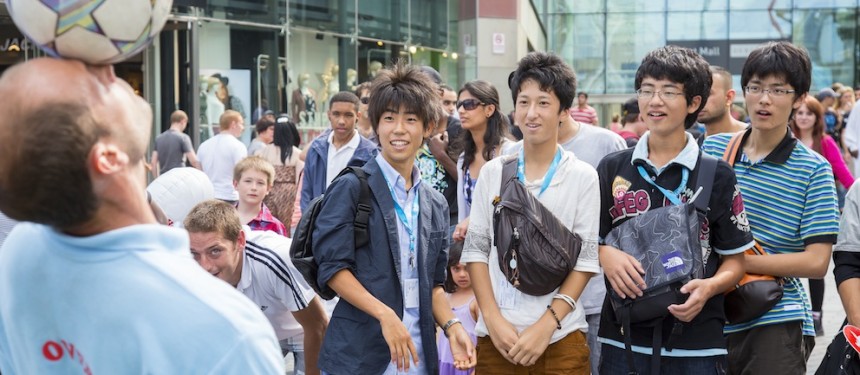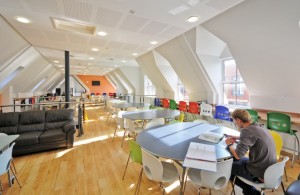The OISE Group – which runs four language brands (as well an international school) offering French and English tuition, and keeps its size below the radar given its independent marketing of these brands (OISE, Regent Language Training, Pilgrims Language Courses and unique schools) – took on 22,000 students in 2011 at 55 adult and junior centres in eight countries. This was up by just 1,000 yet the company increased revenue by £4 million to £40 million.
News and business analysis for Professionals in International Education
Have some pie!
Who is making waves in international education?
 Students studying with Stafford House of English in the UK; operated by one-to-watch CEG. Photo: Roger Harris Photography.
Students studying with Stafford House of English in the UK; operated by one-to-watch CEG. Photo: Roger Harris Photography. Ward Lincoln, head of agent sales, explains this has been achieved through high-price-tag products. “We identified a gap in the market for intensive residential language courses for executive clients which we have gone some way to filling with the opening of OISE at Sherbourne Priors,” he says.
“We identified a gap in the market for intensive residential language courses for executive clients”
“Other developments have been in the secondary education sector with the purchase of two extra buildings in Newbury to satisfy the demand for our international high school, Newbury Hall. We have also opened a new regional office in Poland and several satellite offices in France and Italy.”
Sweden’s STS (Student Travel Schools), a not-for-profit represented in over 40 countries, saw enrolments across its junior language schools, high schools, au pair business and adult international language schools last year climb from 17,300 to 18,200, but revenue drop from €42 million to €39.5 million. A spokesperson says this was “due to low margin, short stay language” trends it has now moved away from and “currency effects”. For 2013 it expects continued growth in the Chinese market plus increased investment in inbound USA for both high school and language school products.
Meanwhile, another Europe-based giant, Sprachcaffe Languages PLUS, which teaches seven languages in 12 countries, saw enrolments rise from 40,000 to 50,000 between 2010 and 2011, driven in part by the acquisition of the GEOS chain of eleven language schools in North America last year. In 2012 it added Italian school Centro Linguistico Italiano Dante Alighieri in Firenze, Italy, bringing its portfolio to 31 schools. In 2013 it will invest €2 million to build the GEOS brand.
In 2013 Sprachcaffe will invest €2 million to build the GEOS brand
Pre-university / higher education
While the recession has arguably had little effect on higher education and pathways operators, changes to visa rules in the UK concerning Highly Trusted Sponsor status have caused turbulence for private HE and pathway providers there, while currency issues have caused problems in Australia.
Navitas has suffered from these trends in its University Programs Division, which offers pathways and degree programmes in 30 colleges worldwide. It saw 14,097 enrolments in financial year 2012, an overall 3% decline against the prior corresponding period, although this reflects a moderately improving situation “as stability returns to the key markets of Australia and the UK following gradual implementation of regulatory changes”, according to the company.
However, growth in the North America region remained strong with Canadian full-time enrolments growing by 22% and its Singapore college recording 11% growth. Navitas also opened three more colleges (two in the UK and one in Australia) in 2012.
“Though there is a continuous need to better understand the ongoing effects of policy changes on the global international education sector, and how they influence students, there are emerging trends of improving demand which should reflect positively in FY13 and beyond,” says CEO, Rod Jones.
Others however have sidestepped the headwinds, such as Kaplan International Colleges, whose seven pathways colleges in the UK saw enrolments climb from 3,000 in 2010 to 4,000 in March 2012, thanks in part to rising interest from Latin America.
INTO University Partnerships which runs 16 partnerships with HE institutions in the UK, US and China, grew its enrolments from 8,177 in 2010-11 to 11,005 in 2011-12.
The company, established by Andrew Colin, who previously set up Study Group, says its revenue climbed from £82 million in 2010/11 to £122 million in 2011/12 and that it plans to launch seven more partnerships into 2013.
“We have continued to adopt a premium pricing position which obviously delivers healthier profit margins”
Fellow UK-based company Cambridge Education Group has also seen promising growth across its five brands, which cover pathways, pre-university courses and language training. Since 2010 it has launched new FoundationCampuses (pathways) with universities in London, Sunderland, Boston and Amsterdam; CATS College high school operations in London and Boston (to complement existing operations); and the Stafford House School of English in London, with new openings slated for 2013.
Head of marketing, Betty Lee, says the company is focusing on margins, not numbers. “We have continued to adopt a premium pricing position which obviously delivers healthier profit margins,” she says.
Total student volumes climbed from 13,000 in 2010/11 to 14,000 in 2011/12, while revenue grew from £44 million to £55 million.

INTO organised a major partners conference in the UK in Dec 2012 (here, at Newcastle United Football Club)
Study Group, another of the ‘G5’ pathways operators – which also operates ELT division Embassy English – continues to build its pathways and HE offerings in North America, Australasia and Europe (through its International Study Centres, Bellerbys and Taylors brands). The company did not provide enrolments for individual divisions but said numbers across the group were currently 60,000, up from 55,000 in 2009-10.
Higher education / business
In the higher education space, global business school HULT – sister company to EF – has continued to be a formidable force. Since 2010 it has opened a campus in San Francisco, expanded its campus in Shanghai, added a second campus in London and opened a rotation campus in Brazil extending its reach to six countries.
While it does not share revenue, its enrolments grew from 1,100 in 2010 to 1,800 in 2011 (projected to pass 2,300 in 2013). The school, which was ranked third in International Business by The Financial Times this year, encourages the use of technology to enhance classroom learning and gives all students an iPad at the start of their course. Students can also spread their courses across Hult’s global campuses for added international experience.
CIBT Education Group has also thrived because of its global reach and canny use of technology. The company runs business and language colleges and cooperative joint programmes in 18 countries, as well as its global learning network – a video conferencing platform that complements its traditional in-class delivery and offers teaching remotely throughout Asia and beyond.
In 2011 its revenue was CAN$58,575,000, up from CAN$55,955,000, and student enrolment 11,640, up from 10,360. Recent expansion highlights include the launch of programmes in northern Iraq and an increase in transfers between its ESL and HE schools.

Ex-UK Prime Minister Tony Blair, Ex-Minister David Blunkett pictured with CEO (centre right) and Group MD (right) of LSBF
UK-based LSBF has also marked itself out as a key player in the private HE space, growing its programme base since 2003 to offer undergraduate and postgraduate degrees as well as professional qualification training. In 2010-11 it opened new campuses in Birmingham, Singapore, Toronto bringing the total to nine, and catered to 25,000 students in 2011 (also via its e-learning platform, Interactive) – up from 17,000.
In an interesting marketing move, LSBF released an exclusive video interview with Tony Blair last year in which he discussed the future of education, in conversation with David Blunkett, ex-UK Education Minister.
The UK arm of LSBF and Interactive, both part of the LSBF Group, generated revenue of over £40 million in 2010-11 (up from £34 million). It is also setting its sights elsewhere. “LSBF aims to increase its presence in the UK, with a particular focus on the undergraduate market, as well as reaching new international markets and expanding its course offering,” says LSBF’S PR and social media executive, Thiago Kiwi.
• This article was first published in August 2012 in print. To see the original unabridged article with additional revenue/student figures, see here.
Still looking? Find by category:




9 Responses to Who is making waves in international education?